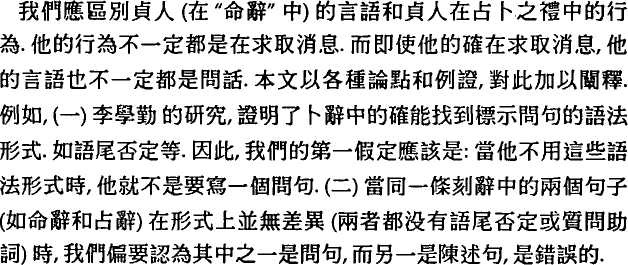No CrossRef data available.
Published online by Cambridge University Press: 26 March 2015
When we read Shang oracle-bone inscriptions, we should distinguish between what the diviner is saying (in the “charge,” mingci) and what he is doing in the whole divination rite. What he is doing is not always seeking information; and even when he is doing this, what he says is usually not a question. This paper offers various arguments and examples to show this. For example, Li Xueqin's research proves that the oracle language possessed grammatical forms, such as final particles and final negatives, for marking a sentence as a question. Therefore, the first assumption should be that when a diviner does not use these forms, he does not intend a sentence to be understood as a question. And when two sentences in the same inscription — e.g., the charge and the prognostication — are alike in form (both of them being without final negatives or interrogative particles), it is a mistake to construe one of them as a question and the other as a statement.

* Together with his response to Qiu Xigui's paper, which follows in the Forum section below, David S. Nivison has suggested that the present conference paper, originally presented to the International Conference on Shang Civilization, East-West Center, Honolulu, Hawaii, September 1982, is directly relevant to Qiu's discussion (indeed, Qiu, who was a participant in that conference, discusses it in some detail) and should be published at this time. It is presented here with only minor changes of format.
1. See Serruys, Paul L-M, “Studies in the Language of the Shang Oracle Inscriptions,” T'oung Pao LX.1-3 (1974), 12-120 Google Scholar; Keightley, David N., “ Shih cheng: A New Hypothesis about the Nature of Shang Divination,” paper presented to the conference “Asian Studies on the Pacific Coast,” Monterey, California, 17 June 1972 Google Scholar. Keightley introduced me to the study of Shang oracle inscriptions, and most of what I have to say in this paper is dependent on his 1972 paper, or on our conversations about this problem since that time.
2.
Xiaoding, Li
![]() , Jiagu wenzi jishi
, Jiagu wenzi jishi
![]() (Taipei: Academia Sinica, 1965), 1104-05Google Scholar.
(Taipei: Academia Sinica, 1965), 1104-05Google Scholar.
3.
Xueqin, Li, “Guanyu Duizu buci de yixie wenti” ![]() , Guwenzi yanjiu
3 (1980), 39-42
Google Scholar.
, Guwenzi yanjiu
3 (1980), 39-42
Google Scholar.
4.
Mengjia, Chen, Yinxu buci zongshu
![]() (Beijing: Kexue chubanshe, 1956), 86-87
Google Scholar.
(Beijing: Kexue chubanshe, 1956), 86-87
Google Scholar.
5. See Keightley, David N., “How the Cracks Were Read: The Existence of the Subcharge,” paper presented to the annual meeting of the Association for Asian Studies, Toronto, 1978 Google Scholar.
6. Karlgren, Bernhard, Grammata Serica Recensa (Stockholm: Museum of Far Eastern Antiquities, 1972), #834g-iGoogle Scholar.
7.
Karlgren, , Grammata Serica Recensa, #834a; Xingwu, Yu
![]() , Jiagu wenzi shilin
, Jiagu wenzi shilin
![]() (Beijing: Zhonghua shuju, 1979), 218-19Google Scholar.
(Beijing: Zhonghua shuju, 1979), 218-19Google Scholar.
8. Karlgren, Grammata Serica Recensa, #833j and #833z.